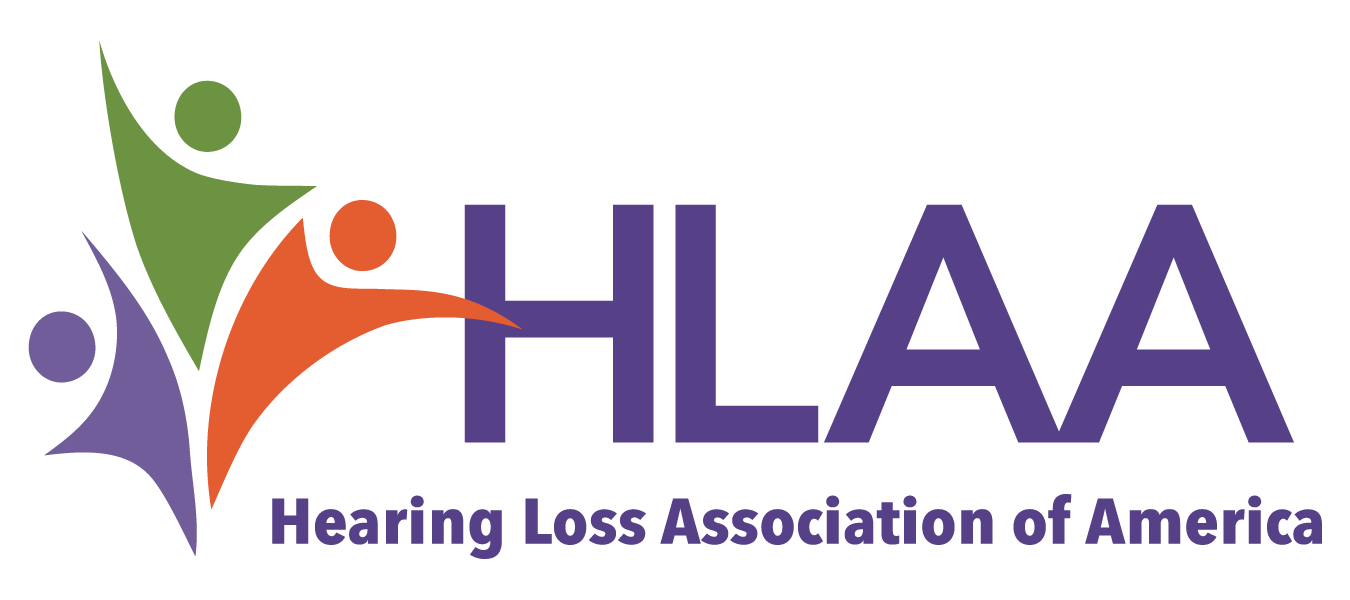How is ICAAT funded?
Who are the partnering organizations behind ICAAT?
ICAAT is a collaboration between Gallaudet University, the Hearing Loss Association of America, and the American Institutes for Research.
About ICAAT
Posted:
Vision:
Industry and consumers working together for mutual benefit to ensure that new and existing technologies improve the quality of life for all consumers who have hearing loss or are Deaf
Mission:
To inspire more accessible, innovative, and responsive technologies from the ground up that meet the needs of consumers who have hearing loss or are Deaf
ICAAT's Origins
The concept for ICAAT was inspired by the work of the Consumer Technology Association (CTA) Foundation. Each year the CTA Foundation brings leaders from the disability and accessibility communities to the Consumer Electronics Show (CES) in order to build relationships between consumers and industry and to highlight technologies and the opportunities for technology to enhance the lives of people with disabilities
The CES activities highlighted the need for an ongoing program and process to continue and expand on those valuable experiences. A set of goals were developed to guide the program from concept to implementation.
- Create an industry and consumer alliance where consumers with hearing loss, Deaf consumers, and technology developers can collaborate for mutual benefit
- Provide explicit understanding of this consumer community and their experiences in the real world
- Foster a participatory process in which the consumer community becomes intrinsic at all stages of and in all facets of design and development
- Inspire and support the development of more usable, accessible, and innovative technology solutions for these consumers
Implementing the Concept
The Industry-Consumer Alliance for Accessible Technology (ICAAT) is a virtual collaborative space for our consumer and industry partners to interact in several ways. ICAAT contains four elements addressing each of our program goals.
ICAAT's Tech Forum is a virtual community of practice welcoming consumers and technology producers. The Tech Forum facilitates discussions between and among consumers and technology producers, encourages the sharing of experiences, knowledge, and ideas around technology topics, and curates relevant resources and event listings.
ICAAT's User Stories share the insights and experiences of everyday consumers with those who work to develop, improve, and expand the use of communication-assistive technologies and mainstream consumer technologies. Personal stories about the daily challenges that consumers, or “users,” face are a valuable and effective way to begin the design process for technology solutions.
ICAAT's Co-Design Connect is a place where Industry can recruit for market research and product testing activities and consumers can learn about and respond to these recruitment opportunities. Industry may also request consultation with subject matter experts at Hearing Loss Association of America.
ICAAT's Co-Design Essentials provides practical information for Consumer and Industry participants when working with each other. Our practical information touches on a whole variety of topics, such as the product design and development process and understanding consent and data usage for Consumers. For Industry, topics such as communication preferences and best practices for providing communication access are discussed.
ICAAT's Funding
ICAAT is a 5-year development project (2019-2024) of the Deaf/Hard of Hearing Technology Rehabilitation Engineering Research Center (DHH Tech RERC) at Gallaudet University in partnership with the American Institutes for Research and Hearing Loss Association of America. The DHH Tech RERC is funded by the National Institute on Disability, Independent Living, and Rehabilitation Research (NIDILRR).
The contents of this site were developed under this NIDILRR grant (number 90REGE0013). NIDILRR is a Center within the Administration for Community Living (ACL), Department of Health and Human Services (HHS). The contents of this site do not necessarily represent the policy of NIDILRR, ACL, HHS, and you should not assume endorsement by the Federal Government.
What we have to do is make sure that we all think about accessibility from the ground up. I don't want it to be something that we nail on and append at the end. ...think about it as a level of design.
By the Numbers
Posted:
People with hearing loss can be found at every age, in every demographic.
In the United States, approximately 15% of adults (37.5 million) aged 18 and over report some trouble hearing.
The National Institute on Deafness and Other Communication Disorders (NIDCD) also reports:
- Age is the strongest predictor of hearing loss among adults
- About 2 percent of adults aged 45 to 54 have disabling hearing loss. The rate increases to 8.5 percent for adults aged 55 to 64. Nearly 25 percent of those aged 65 to 74 and 50 percent of those who are 75 and older have disabling hearing loss.
- Men are almost twice as likely as women to have hearing loss among adults aged 20-69.
- Non-Hispanic whites are more likely than adults in other racial/ethnic groups to have hearing loss; non-Hispanic blacks have the lowest prevalence of hearing loss among adults aged 20-69.
The World Health Organization (WHO) provides global statistics on the prevalence of deafness and hearing loss.
Information on the use of signed and spoken communication methods among individuals with hearing loss is much less well defined. We know that most people with hearing loss use spoken language for communication, primarily because their hearing loss occurred in their adult years, long after they acquired language.
In the United States, an estimate from the early 1970s suggests that as many as 500,000 people of the more than 37.5 million with hearing loss communicate using American Sign Language (ASL) at home. This estimate has not been updated mainly because neither census nor health surveys since then have included questions on the use of ASL1.
1 Mitchell, R. E., Young, T. A., Bachelda, B., & Karchmer, M. A. (2006). How Many People Use ASL in the United States?: Why Estimates Need Updating. Sign Language Studies, 6(3), 306–335. http://www.jstor.org/stable/26190621

Identity and Communication
Posted:
There are important differences in how people in this large, varied consumer community view identity and prefer to communicate.
Language and words related to identity matter and can be tricky to know how to use. Sometimes you must make a judgment call about how you address identity and which related words you choose to use. While you may not satisfy everyone’s preferences, you can become familiar with terms that are generally accepted within the community, as well as those that are not.
Some individuals consider themselves members of the Deaf community, with a unique culture and language. These individuals typically use sign language as their primary language and consider deafness a difference of experience rather than a limitation. Members of the Deaf community may identify as “deaf or hard of hearing.” The word deaf is capitalized (Deaf) when referring to this community to reflect and recognize the shared culture and experiences of its members.
Other individuals view their identities differently. These individuals prefer to or may only communicate using spoken language and are strongly interested in maximizing hearing through personal and assistive technology use. They are more likely to be people who developed their hearing loss as an adult; hence they tend to use people-first language and identify as “people with hearing loss.” Hearing status and communication preference are not necessarily related to their identity in the same way or to the same degree as they are for members of the Deaf community.
As with everything, there are exceptions to these generalizations. Some people may consider themselves members of the Deaf community, use hearing technologies and switch between the use of sign language and spoken communication depending on the situation. Using "individuals with hearing loss, deaf, and hard of hearing" as the language and words in your communications with consumers you want to recruit bridges the various constituencies within this diverse community.
Likewise, there are terms that are generally either considered offensive or inappropriate by this community. We suggest you avoid using the term "hearing impaired." We also suggest you avoid the term "normal" hearing. Instead, we suggest simply using the term "hearing" if you are interested in recruiting hearing individuals along with individuals with hearing loss and deaf or hard of hearing individuals for your product development and testing work.
If you are working with a particular consumer organization, such as the Hearing Loss Association of America (HLAA), the National Association of the Deaf (NAD), or Telecommunications for the Deaf and Hard of Hearing, Inc. (TDI), they can provide guidance with regard to identity terminology and the communication preferences of their constituents. The best practice, because each consumer is a different individual, is to directly discuss with participating consumers their communication access needs and preferences for the particular meeting or event you are hosting.

Communication Access: What to Know
Posted:
ICAAT encourages all companies, from startups to established companies, to provide communication access services for participants in their research and testing activities. Communication access services ensure communication is equally effective for all participants so that everyone can understand what is said or written and can convey messages, so they are understood by others.
In some cases, companies may provide specific communication access services to all participants in a research or testing event. For example, a company may provide automatic speech recognition (ASR) captioning for all participants if they are doing interviews over a videoconferencing platform, such as Zoom or Microsoft Teams. If you feel a provided access service does not meet your communication needs, you should make sure to state this upfront when inquiring about a recruitment opportunity. In other cases, a company may provide communication access services upon request, but the service must be requested by participants in advance of the research or testing event.
While ICAAT believes it is the responsibility of the event host to provide communication access services, it is the responsibility of participants to make their communication access needs known as early as possible. Communication access services can take time to arrange so making your need(s) known as soon as possible is important.
ICAAT provides companies with practical information on various communication access options for people with hearing loss and the best practices for implementing them. Communication access usually involves the provision of one or a combination of the following technologies and services: real-time captioning, assistive listening systems, or sign language interpretation. Equally important is setting communication ground rules for all participants about what is expected of them to support effective communication. If you are unfamiliar with or want to learn more about any of these technologies, services, or practices, you can read the Co-Design Essentials page for Industry on Communication Access.

Non-Endorsement Policy
Posted:
ICAAT cannot be used for marketing purposes. ICAAT does not endorse, promote or advertise any product or service.
Hearing Loss Association of America (HLAA) is a consumer organization and partner in ICAAT. HLAA provides information and education about technology that can benefit people with hearing loss. HLAA has a strict policy of non-endorsement of goods, products, and services.
Individual consumers participating in ICAAT are prohibited from using the names, logos, or images associated with ICAAT and its partner organizations (HLAA, Gallaudet University, and AIR) via any media, including written testimonies, social media, in photos or videos to suggest or imply endorsement by these organizations in personal representations about goods, products, or services tested or encountered through association with ICAAT.

Consent & Personal Data Usage
Posted:
Ethics is an essential consideration in all types of research that include people and the collection and use of their data. Informed consent is fundamental to ensuring data collection is ethical.
What is informed consent?
Informed consent means that before the research starts,
- you have received all the important details about the research in clear, understandable language,
- you have enough time and opportunity to ask questions and receive clarification, so you fully understand the details of the research, and
- you freely decide whether to participate in the research.
What important details about the research should I receive?
- An explanation with enough detail so you understand the purpose and objectives of the research.
- A description of the activities you will complete and how long those activities are expected to last.
- A description of benefits, if any, that you might reasonably expect from participation in the research.
- A description of risks or discomfort, if any, that you might reasonably expect from participation in the research.
- A statement about how your information and data will be recorded (for example, written, photographic, audio, or video), stored, and used.
- A statement about how your privacy and the confidentiality of your information and data will be handled.
- Information about whether you will receive compensation for your time, expenses incurred, experience, and perspective and what form compensation will take.
- Contact information for a person who can answer any questions, provide clarification, and with whom you can easily and quickly communicate about the research.
- A way for you to consent (for example, by signing a form) to participating in the research.
How will I receive the important details about the research?
You can receive these details in several ways. For example, you might receive the information through face-to-face contact, videoconference, email, mail, telephone, or video. To ensure informed consent, the important details about the research often are provided using a written informed consent form that you sign and date. If you have signed an informed consent form to participate in research, you should receive a copy of it, so you can refer to the form at any time.
Written informed consent forms have several advantages. They provide written documentation. The copy you receive ensures you know what you signed and who to contact about the research. Written forms also provide evidence that the researchers have thought through the important details about the research, and all participants receive the same information.
It is important to note that even if you have signed a form or provided consent in another way, you can change your mind and withdraw anytime, for any reason, or for no reason at all.
Data is valuable and powerful. Organizations have a responsibility to make sure it is protected and used ethically.

What's an NDA?
Posted:
An NDA is a non-disclosure agreement. Sometimes, they also are referred to as confidentiality agreements.
When working with a company whether you are participating in market research, product testing, or some other activity, it is possible the company may require that you sign a non-disclosure agreement or NDA in order for you to participate. NDAs are commonplace business documents companies use to protect any valuable or sensitive information they may provide from becoming public or shared with their competitors.
Non-disclosure agreements are legal documents. They are written contracts that are intended to be enforceable by law, so they should be taken seriously. If you are asked to sign an NDA by a company, you should read the document carefully and ensure that you fully understand your responsibilities described in the agreement. If there is something you do not understand or want more information about, you should seek clarification or ask questions before signing the NDA.
Non-disclosure agreements can take a variety of forms, contain various elements, and have different levels of complexity. However, all non-disclosure agreements have several elements in common. NDAs should:
- include the names of the parties who are involved in providing and receiving the confidential information.
- clearly identify the information that you must keep confidential
- specify when the agreement ends
- describe the consequences if you do not keep the information confidential
The bottom line...
Make sure you understand any document you are asked to sign before signing it. If you sign an NDA, do not share the confidential information you receive from the company with others for as long as the non-disclosure agreement is in effect.



